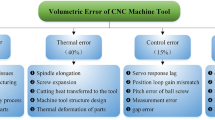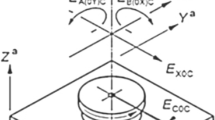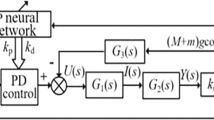Abstract
In order to satisfy the requirements of large workspace and high dexterity for processing equipment of oversized cylindrical boxes’ spherical crown surfaces in the aerospace industry, a novel serial-parallel hybrid processing robot mechanism is proposed. The degrees of freedom of the 5PUS-(2UR)PU parallel mechanism are obtained by using the screw theory. The inverse kinematics of the hybrid mechanism are analyzed and the velocity Jacobian matrix is established. Then, the constraints of the main factors influencing workspace of the mechanism are given, and the position and posture workspace are obtained. Next, the dexterity and stiffness performance of the mechanism is analyzed based on the Jacobian matrix. The virtual prototype is established, and the theoretical calculation and simulation analysis of the hybrid mechanism with arc curve as the processing trajectory are carried out by using Matlab and Adams software. The research results show that the mechanism can satisfy the requirements of large workspace and high dexterity of oversized cylindrical boxes’ spherical crown surface processing, and has feasibility and practical application value.
Similar content being viewed by others
References
C. S. G. Lee, M. Ziegler. Geometric approach in solving inverse kinematics of PUMA robots. IEEE Transactions on Aerospace and Electronic Systems, vol. AES-20, no. 6, pp. 695–706, 1984. DOI: 10.1109/TAES.1984.310452.
A. Omodei, G. Legnani, R. Adamini. Three methodologies for the calibration of industrial manipulators: Experimental results on a SCARA robot. Journal of Robotic Systems, vol. 17, no. 6, pp. 291–307, 2000.
A. Nubiola, I. A. Bonev. Absolute calibration of an ABB IRB 1600 robot using a laser tracker. Robotics and Computer-Integrated Manufacturing, vol. 29, no.1, pp. 236–245, 2013. DOI: 10.1016/j.rcim.2012.06.004.
A. Pashkevich, D. Chablat, P. Wenger. Stiffness analysis of overconstrained parallel manipulators. Mechanism and Machine Theory, vol. 44, no.5, pp. 966–982, 2009. DOI 10.1016/j.mechmachtheory.2008.05.017.
H. Q. Zhang, H. R. Fang, B. S. Jiang. Motion-force trans-missibility characteristic analysis of a redundantly actuated and overconstrained parallel machine. International Journal of Automation and Computing, vo. 16, no. 2, pp. 150–162, 2019. DOI: 10.1007/s11633-018-1156-5.
B. S. Jiang, H. R. Fang, H. Q. Zhang. Type synthesis and kinematics performance analysis of a class of 3T2R parallel mechanisms with large output rotational angles. International Journal of Automation and Computing, vol. 16, no.6, pp. 775–785, 2019. DOI: 10.1007/s11633-019-1192-9.
M. Mazare. M. Taghizadeh, M. R. Najafi. Kinematic analysis and design of a 3-DOF translational parallel robot. International Journal of Automation and Computing, vol. 14, no.4, pp. 432–441, 2017. DOI: 10.1007/s11633-017-1066-y.
Z. Ga, D. Zhang. Performance analysis mapping and multiobjective optimization of a hybrid robotic machine tool. IEEE Transactions on Industrial Electronics, vol. 62, no.1, pp. 423–433, 2015. DOI: 10.1109/TIE.2014.2327008.
F. Gao, B. B. Peng, H. Zhao, W. M. Li. A novel 5-DOF fully parallel kinematic machine tool. The International Journal of Advanced Manufacturing Technology, vol. 31, no. 1–2, pp. 201–207, 2006. DOI: 10.1007/s00170-005-0171-1.
S. Kucuk. Dexterous workspace optimization for a new hybrid parallel robot manipulator. Journal of Mechanisms and Robotics, vol. 10, no. 6, Article number 064503, 2018. DOI: 10.1115/1.4041334.
T. K. Tanev. Kinematics of a hybrid (parallel-serial) robot manipulator. Mechanism and Machine Theory, vol. 35, no.9, pp. 1183–1196, 2000. DOI: 10.1016/S0094-114X(99)00073-7.
F. G. Xie, X. J. Liu, H. Zhang, J. S. Wang. Design and experimental study of the SPKM165, a five-axis serial-parallel kinematic milling machine. Science China Technological Sciences, vol. 54, no.5, pp. 1193–1205, 2011. DOI 10 1007/s11431-011-4314-3.
F. Q. Zhao, S. Guo, Z. C. Xu, D. Li. Design and analysis of high performance machine tool based on redundant parallel mechanism. Journal of Central South University (Science and Technology), vol. 50, no.1, pp. 67–74, 2019. DOI: 10.11817/j.issn.1672-7207.2019.01.010. (in Chinese)
B. Siciliano. The Tricept robot: Inverse kinematics, ma-nipulability analysis and closed-loop direct kinematics algorithm. Robotica, vol. 17, no.4, pp. 437–445, 1999. DOI: 10.1017/S0263574799001678.
Z. M. Bi, Y. Jin. Kinematic modeling of Exechon parallel kinematic machne. Robotics and Computer-Integrated Manufacturing, vol. 27, no.1, pp. 186–193, 2011. DO: 10.1016/j.rcim.2010.07.006.
Y. Q. Zhao, Y. Jin, J. Zhang. Kinetostatic modeling and analysis of an exechon parallel kinematic machine (PKM) module. Chinese Journal of Mechanical Engineering, vol. 29, no. 1, pp. 33–44, 2016. DOI: 10.3901/CJME.2015.1012.120.
B. B. Lian, T. Sun, Y. M. Song, Y. Jin, M. Price. Stiffness analysis and experiment of a novel 5-DOF parallel kinematic machine considering gravitational effects. International Journal of Machine Tools and Manufacture, vol. 95, pp. 82–96, 2015. DOI: 10.1016/j.ijmachtools.2015.04.012.
T. Huang, M. Li, X. M. Zhao, J. P. Mei, D. G. Chetwynd, S. J. Hu. Conceptual design and dimensional synthesis for a 3-DOF module of the TriVariant-a novel 5-DOF recon-figurable hybrid robot. IEEE Transactions on Robotics, vol. 21, no. 3, pp. 449–456, 2005. DOI: 10.1109/TRO.2004.840908.
H. T. Liu, T. Huang, J. P. Mei, X. M. Zhao, D. G. Chetwynd, M. Li, S. J. Hu. Kinematic design of a 5-DOF hybrid robot with large workspace/limb-stroke ratio. Journal of Mechanical Engineering, vol. 129, no.5, pp. 530–537, 2007. DOI: 10.1115/1.2712220.
C. L. Dong, H. T. Liu, W. Yue, T. Huang. Stiffness modeling and analysis of a novel 5-DOF hybrid robot. Mechanism and Machine Theory, vol. 125, pp. 80–93, 2018. DOI: 10.1016/j.mechmachtheory.2017.12.009.
Y. M. Song, B. B. Lian, T. Sun, G. Dong, Y. Qi, H. Gao. A novel five-degree-of-freedom parallel manipulator and its kinematic optimization. Journal of Mechanisms and Robotics, vol. 6, no. 4, Article number 041008, 2014. DOI: 10.1115/1.4027742.
H. Yang, H. R. Fang, Y. F. Fang, H. B. Qu. Kinematics performance and dynamics analysis of a novel parallel perfusion manipulator with passive link. Mathematical Problems in Engineering, vol. 2018, Article number 6768947, 2018. DOI: 10.1155/2018/6768947.
H. Yang, H. R. Fang, D. Li, Y. F. Fang. Kinematics analysis and multi-objective optimization of a novel parallel perfusion robot. Journal of Beijing University of Aeronautics and Astronautics, vol. 44, no.3, pp. 568–575, 2018. DOI: 10.13700/j.bh.1001-5965.2017.0157. (in Chinese)
M. Toz, S. Kucuk. Dimensional optimization of 6-DOF 3-CCC type asymmetric parallel manipulator. Advanced Robotics, vol. 28, no.9, pp. 625–637, 2014. DOI: 10.1080/01691864.2014.884935.
F. G. Xie, X. J. Liu, Z. You, J. S. Wang. Type synthesis of 2T1R-type parallel kinematic mechanisms and the application in manufacturing. Robotics and Computer-Integrated Manufacturing, vol. 30, no.1, pp. 1–10, 2014. DOI: 10.1016/j.rcim.2013.07.002.
Y. Kakinuma, K. Igarashi, S. Katsura, T. Aoyama. Development of 5-axis polishing machine capable of simultaneous trajectory, posture, and force control. CIRP Annals, vol. 62, no.1, pp. 379–382, 2013. DOI: 10.1016/j.cirp.2013.03.135.
D. C. Zhu, Z. M. Yan, X. F. Cui, P. Li. Kinematics analysis and simulation of 3-RPS-type parallel robot based on screw theory. Mechanical Science and Technology for Aerospace Engineering, vol. 32, no.1, pp. 28–31, 2013. DOI: 10.13433/j.cnki.1003-8728.2013.01.010. (in Chinese)
G. Coppola, D. Zhang, K. F. Liu. A 6-DOF reconfigurable hybrid parallel manipulator. Robotics and Computer-Integrated Manufacturing, vol. 30, no.2, pp. 99–106, 2014. DOI: 10.1016/j.rcim.2013.09.011.
X. J. Liu, Z. L. Jin, F. Gao. Optimum design of 3-DOF spherical parallel manipulators with respect to the conditioning and stiffness indices. Mechanism and Machine Theory, vol. 35, no.9, pp. 1257–1267, 2000. DOI: 10.1016/S0094-114X(99)00072-5.
Acknowledgements
This work was supported by Fundamental Research Funds for the Central Universities (No. 2018JBZ007).
Author information
Authors and Affiliations
Corresponding author
Additional information
Hai-Rong Fang received the B. Eng. degree in mechanical engineering from Nanjing University of Science and Technology, China in 1990, the M. Eng. degree in mechanical engineering from Sichuan University, China in 1996, and the Ph. D. degree in mechanical engineering from Beijing Jiaotong University, China in 2005. She worked as an associate professor in Department of Engineering Mechanics, Beijing Jiaotong University, China from 2003 to 2011. She is a professor in School of Mechanical Engineering from 2011 and director of Robotics Research Center.
Her research interests include parallel mechanisms, digital control, robotics and automation, and machine tool equipment.
Tong Zhu received the B. Eng. degree in mechanical engineering from Beijing Jiaotong University, China in 2017. Currently, he is a master student at School of Mechanical, Electronic and Control Engineering, Beijing Jiaotong University, China.
His research interests include robotics in computer integrated manufacturing and parallel kinematics machine tool.
Hai-Qiang Zhang received the B. Eng. degree in mechanical design and theories from Yantai University, China in 2012, the M. Eng. degree in mechanical engineering from Hebei University of Engineering, China in 2015. He is a Ph. D. degree candidate at Beijing Jiaotong University, China.
His research interests include robotics in computer integrated manufacturing, parallel kinematics machine tool, redundant actuation robots, over-constrained parallel manipulators, and multi-objective optimization design.
Hui Yang received the B. Eng. degree in mechanical engineering from Beijing Jiao-tong University, China in 2014. She is currently a Ph. D. degree candidate at School of Mechanical, Electronic and Control Engineering, Beijing Jiaotong University, China.
Her research interests include robotics in computer integrated manufacturing and parallel kinematics machine tool.
Bing-Shan Jiang received the B. Eng. degree in mechanical electronic engineering from Liaoning Technical University, China in 2015, and the M. Eng. degree in mechanical engineering from Liaoning Technical University, China in 2017. He is currently a Ph. D. degree candidate at School of Mechanical, Electronic and Control Engineering, Beijing Jiaotong University, China.
His research interests include synthesis, kinematics, dynamics and control of parallel robots.
Rights and permissions
About this article
Cite this article
Fang, HR., Zhu, T., Zhang, HQ. et al. Design and Analysis of a Novel Hybrid Processing Robot Mechanism. Int. J. Autom. Comput. 17, 403–416 (2020). https://doi.org/10.1007/s11633-020-1228-1
Received:
Accepted:
Published:
Issue Date:
DOI: https://doi.org/10.1007/s11633-020-1228-1




